For the first time in a number of years, the US Federal Reserve has raised interest rates in line with its forecasts made at the start of the year, by taking the target rate for the Fed funds up a total of three times over 2017, having completed the third hike just last week.
With the markets having misjudged the Fed's "dot plot" in 2017, this should have a bearing on how they view US interest rates next year, with the Federal Open Market Committee (FOMC) again predicting another three interest rate rises in 2018, and two more in 2019.
In the past few years, it has broadly been right for the markets to doubt the Fed's intentions to raise interest rates, with it only hiking once in each of the previous two years. But with the FOMC now fulfilling its forecasts, it is probably fair to assume that more hikes are on their way, and the markets will have to begin pay the Fed's "dots" more respect.
This should also have an impact on how local markets will behave. Given the pegged currencies in the region, GCC central banks typically follow US Fed interest-rate decisions.
But in common with their global counterparts, local markets have been largely sceptical about the Fed in recent years, with companies remaining reluctant to hedge interest rate risk as expectations of future rate hikes have been doubted.
This may also begin to change, however, especially at the short end of the interest rate curve, where further hikes are expected.
Other factors have also been keeping local interest rates subdued however, and these may also continue to offset the full impact of policy moves on local rates.
While policy rates in the region have generally followed the Fed move, interbank rates have increased at a much slower pace than the increase in the USD Libor (London Interbank Offered Rate) rates, mainly as a result of higher oil prices boosting the liquidity in the local banking systems.
Although 3-month (3m) Emirates Interbank Offered Rate (Eibor) rate has increased from 1.38 per cent in February this year to 1.72 per cent now, the current spread between 3m Eibor and 3m Libor at only 14 basis points (bps) is at its lowest since the financial crisis. Thus while US rate hikes in 2018 will likely see further increases in Eibor rates, the spread against Libor may still remain compressed.
______
Read more:
[ Three key events that will help shape the financial markets in 2018 ]
Central banks take the driving seat on monetary policy normalisation
Equities have outperformed other assets classes in 2017
______
Another question to consider is what will happen to the long end of the US rate curve. As is logical, the US Treasury (UST) yield curve steepens at the beginning of any rate hike cycle, and then flattens over the rest of the rate hike cycle.
With five rate hikes done in the current cycle and approximately five more to go before reaching the Fed's projected long term terminal rate of 2.75 per cent, it is not unreasonable to see the UST curve flattening.
In this cycle, the flattening of the curve is getting exaggerated attention, mainly because the longer end of the yield curve has failed to register any increase despite five rate hikes to date. 10-year yields have remained muted and at 2.36 per cent are only 10bps away from where they were before the first rate hike in December 2015.
To some extent, this is a technical issue related to an eroding "term premium", rather than being related to the real economy, a factor cited by Janet Yellen last week. Going forward however, much will depend on whether we really are in the middle of the Fed's tightening cycle.
While the rest of the bond market took the Federal Reserve's latest interest-rate increase in its stride, Libor is surging.
The steady march higher in Libor shows the US central bank's tightening cycle does have consequences, even as measures of overall financial conditions have eased as the Fed hiked rates this year.
Libor serves as the basis for trillions of dollars in loans and floating-rate securities and affects borrowing rates for many corporates.
Three-month USD Libor closed at 1.61 per cent at the end of last week, the highest level since the global financial crisis in 2008. Markets will probably have to come to terms with it rising much further before any end comes into sight.
Tim Fox is chief economist and head of research at Emirates NBD






